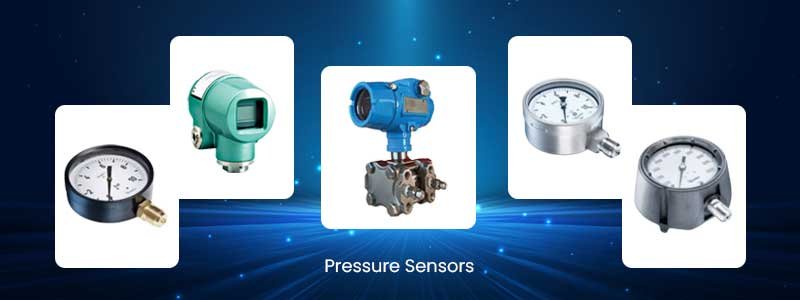How Pressure Sensors and Switches Keep Things Running Smoothly
For almost everyone it is those massive machines or complex control panels that factories, power plants and modern buildings running without a hitch. Little do they know that the most crucial roles are being played by the devices they rarely see like –
- Pressure sensors, and
- Switches
In particular, differential pressure transmitters and differential pressure switches are what ensure that the processes work safely, efficiently, and reliably.
What Is Differential Pressure?
Let’s understand it this way – pressure is just the force exerted by a fluid (like air, water, or oil) on a surface. And differential pressure, also known as “Delta P” or “DP,” is the difference in pressure between two points in a system.
For example, there is a pipe with water flowing through it. When you measure the pressure at the start and the end of the pipe, the difference between those two readings is the differential pressure. Why do you have to measure this pressure?
It is because when you monitor, it tells you so much about what is going inside the system. You’ll know if whatever is inside it is flowing the way it should, or if a blockage is there, or the filter needs to be replaced.
The Working Of Differential Pressure Transmitters
When you look inside a differential pressure transmitter, you will be able to see two ports –
- One for high pressure
- One for low pressure
Each of these ports are connected to a sealed metal diaphragm, and as the pressure is applied, these diaphragms deform a little bit. After this, the transmitter’s electronics then measure this deformation and translate it into an electrical signal.
Applications In Real Life
Flow Measurement
The pressure transmitter has a leading role in flow management. If you have to calculate how fast a liquid or gas is flowing, measure the pressure drop across an orifice plate or a special tube in a pipe. Not only is this useful for monitoring , but also for ensuring that systems operate efficiently.
Level Measurement
In closed tanks, measuring the pressure difference between the bottom and the top tells you how much liquid is inside—without ever opening the tank. This is particularly useful in industries like food and beverage, where maintaining the right level of ingredients is vital for product consistency.
Filter Monitoring
If a filter gets clogged, the pressure before and after it will change. A differential pressure transmitter spots this instantly, so maintenance teams know when to act. This proactive monitoring can save companies a lot of time and money by preventing unexpected downtime.
Safety Systems
In industries like oil and gas, these transmitters help detect leaks, monitor extraction processes, and ensure everything stays within safe limits. They are vital for maintaining safety standards and protecting both workers and the environment.
Process Control
Beyond these applications, differential pressure transmitters are also essential in process control systems. They help maintain optimal operating conditions by providing real-time data that can be used to adjust valves and pumps automatically.
Differential Pressure Switches – How Do They Work?
Similar to pressure transmitters, the switches also have two ports – high and low pressure. Inside, a diaphragm or piston reacts to the difference between them. When that difference hits a set limit, it triggers a switch—sort of like a pressure-activated light switch, but way cooler because it’s all automatic.
Where Are They Used?
- Safety Shutdowns – If a filter clogs or a pump fails, the switch can immediately shut down equipment to prevent damage.
- Alarms – When pressure differences go outside safe limits, the switch can sound an alarm, alerting operators to take action.
- Automation – In HVAC systems, differential pressure switches help control airflow and keep conditions comfortable and safe.
Why Do Both Devices Matter?
You must be wondering why use both –
- Differential pressure transmitter, and
- Differential pressure switches
The answer is straight — both of these serve a different purpose. Transmitters provide continuous, precise data for monitoring and control, while switches offer instant action when something goes wrong.
Everyday Benefits
Think about it—every single day, differential pressure transmitters and switches are quietly making life easier for all kinds of industries. For one, they’re real energy savers. By keeping an eye on flow and pressure, these devices help systems run at their best, which means less wasted energy and, yes, lower bills!
Who wouldn’t want that? They’re also like early warning systems for your equipment. If there’s a blockage or a leak, you’ll know about it right away, so you can fix things before they turn into expensive problems or unexpected shutdowns. And let’s not forget about safety. These smart devices can trigger automatic shutdowns or sound alarms if something’s not right, protecting both people and machinery from harm.
On top of all that, they make sure everything stays on track—so your processes stay within the right limits and your product quality never slips. Honestly, it’s hard to imagine running a smooth operation without them. They’re a win-win for everyone involved!
In a Nutshell
You know, differential pressure transmitters and switches might not be the coolest or flashiest parts of any industrial setup, but they’re seriously important. They’re like the quiet helpers working behind the scenes, making sure everything runs without a hitch.
Whether it’s at a chemical plant, a water treatment facility, or even the ventilation system in your office, these devices keep things safe and smooth by giving key info and reacting fast when something’s off.
So, next time you turn on the tap or feel fresh air flowing, just remember—its differential pressure transmitter and differential pressure switches keeping everything working just right!


